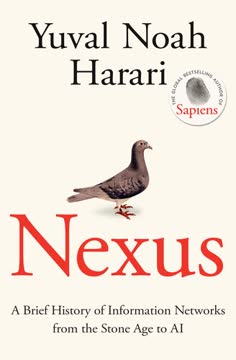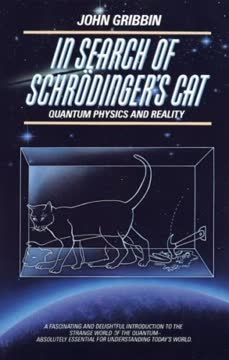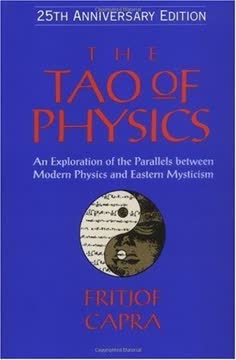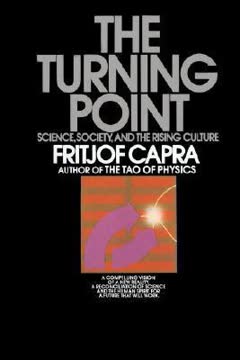Key Takeaways
1. Modern Physics and Eastern Mysticism Converge on Unity
The concepts of modern physics often show surprising parallels to the ideas expressed in the religious philosophies of the Far East.
Shared Vision. Modern physics and Eastern mysticism, despite their different origins and methodologies, arrive at a remarkably similar worldview. Both emphasize the interconnectedness of all things, challenging the classical Western notion of separate, independent entities. This convergence suggests a deeper, more holistic understanding of reality.
Beyond Technology. The influence of modern physics extends beyond technology, impacting thought and culture by revising our conception of the universe and our relationship to it. This revision aligns with the core tenets of Eastern mysticism, which also seeks to understand the essential nature of reality.
Ancient Echoes. The parallels between modern physics and Eastern mysticism represent a return to the holistic philosophies of early Greek thinkers, who saw no separation between science, philosophy, and religion. This cyclical evolution of Western thought suggests a deeper, more enduring truth that transcends cultural and historical boundaries.
2. Rational vs. Intuitive Knowledge: Two Paths to Truth
Not knowing that one knows is best.
Complementary Knowledge. Human understanding encompasses both rational and intuitive modes of knowing, traditionally associated with science and religion, respectively. While Western culture often favors rational knowledge, Eastern traditions emphasize the value of intuitive insight.
Limitations of Intellect. Rational knowledge, derived from sensory experience and intellectual analysis, is inherently limited by its abstract and conceptual nature. It can never fully capture the infinite complexity and interconnectedness of reality.
Direct Experience. Eastern mysticism seeks a direct, non-intellectual experience of reality that transcends sensory perception and conceptual thinking. This "absolute knowledge" is characterized by a sense of undifferentiated unity and oneness with the universe.
3. Language as a Limited Tool: Paradoxes in Physics and Mysticism
The Tao that can be expressed is not the eternal Tao.
Inadequacy of Words. Both physicists and mystics grapple with the limitations of language in describing their respective experiences of reality. Ordinary language, rooted in sensory experience, proves inadequate for conveying the paradoxical and often contradictory nature of the atomic world and mystical insights.
Paradoxical Expression. To communicate their knowledge, both physicists and mystics often resort to paradoxical statements and logical contradictions. These paradoxes serve to challenge conventional thinking and point beyond the limitations of language.
Zen Koans. Zen Buddhism utilizes koans, nonsensical riddles, to disrupt the thought process and facilitate a direct, nonverbal experience of reality. Similarly, physicists confront "quantum koans" that demand a new awareness to resolve.
4. Classical Physics' Mechanistic Worldview Is Overturned
As far as the laws of mathematics refer to reality, they are not certain; and as far as they are certain, they do not refer to reality.
Newtonian Limitations. The mechanistic worldview of classical physics, based on Newton's laws of motion and the concept of a clockwork universe, dominated scientific thought for centuries. However, the discoveries of modern physics revealed the limitations of this model, particularly at the atomic and subatomic levels.
Revolutionary Theories. Relativity theory and quantum theory shattered the fundamental concepts of the Newtonian worldview, including absolute space and time, elementary solid particles, and strict causality. These new theories necessitated a radical shift in our understanding of the universe.
Holistic and Organic. Modern physics has moved away from the fragmented, mechanistic view of classical physics towards a more holistic and organic understanding of nature. This new worldview emphasizes the interconnectedness of all phenomena and the dynamic nature of reality.
5. Hinduism: The Universe as Brahman's Divine Play
This that people say, “Worship this god! Worship that god!”—one after another—this is his [Brahman’s] creation indeed! And he himself is all the gods.
Ultimate Reality. Hinduism posits Brahman as the ultimate reality, the unifying principle underlying all things and events in the universe. Brahman is the "soul" or inner essence of all existence, transcending intellectual comprehension and verbal description.
Mythological Manifestations. The Hindu tradition uses a vast pantheon of gods and goddesses to represent different aspects of Brahman. These deities are not seen as separate entities but as reflections of the one ultimate reality, each embodying a particular facet of the Divine.
Dynamic Interplay. The universe is conceived as lila, the divine play of Brahman, a rhythmic and dynamic process of creation, preservation, and destruction. Karma, the principle of action, drives this play, connecting all things in a web of cause and effect.
6. Buddhism: Transcending Suffering Through Impermanence
All things arise and pass away.
The Four Noble Truths. Buddhism centers on the Four Noble Truths, which address the nature of suffering (duhkha), its cause (trishna), its cessation (nirvana), and the path to liberation (the Eightfold Path). This framework offers a practical guide to overcoming human frustration and achieving enlightenment.
Impermanence and Non-Self. A core tenet of Buddhism is the impermanence of all things, including the self. Clinging to fixed forms, whether objects, people, or ideas, leads to suffering. Recognizing the illusion of a separate, permanent self is key to liberation.
The Eightfold Path. The Eightfold Path provides a practical guide to self-development, encompassing right understanding, thought, speech, action, livelihood, effort, mindfulness, and concentration. This path leads to nirvana, a state of liberation from suffering and the cycle of rebirth.
7. Taoism: Harmony with the Dynamic Flow of the Tao
He who conforms to the course of the Tao, following the natural processes of Heaven and Earth, finds it easy to manage the whole world.
The Way of the Universe. Taoism emphasizes living in harmony with the Tao, the cosmic process or "Way" of the universe. This involves observing nature, understanding its patterns, and acting spontaneously in accordance with its flow.
Yin and Yang. The dynamic interplay of yin and yang, the polar opposites, is central to Taoist thought. All manifestations of the Tao arise from this interplay, and the sage seeks to maintain a balance between these forces.
Wu-Wei. Wu-wei, or "non-action," is a key concept in Taoism, referring to acting spontaneously and effortlessly in accordance with the Tao. This involves refraining from actions that are contrary to nature and trusting one's intuitive intelligence.
8. Zen: Direct Experience Beyond Words and Logic
The instant you speak about a thing you miss the mark.
Emphasis on Satori. Zen Buddhism prioritizes the direct experience of enlightenment (satori) above all else. It eschews intellectual analysis, philosophical speculation, and reliance on scriptures, focusing instead on immediate, intuitive insight.
Direct Pointing. Zen masters employ "direct pointing" techniques, such as koans and spontaneous actions, to disrupt the student's reliance on logic and reasoning. These methods aim to trigger a sudden awakening to the true nature of reality.
Everyday Mind. Zen emphasizes the integration of enlightenment into everyday life. The goal is not to withdraw from the world but to live naturally and spontaneously, finding wonder and mystery in ordinary activities.
9. Quantum Theory: The Observer's Role in Shaping Reality
Isolated material particles are abstractions, their properties being definable and observable only through their interaction with other systems.
Interconnectedness. Quantum theory reveals a fundamental interconnectedness of the universe, challenging the classical notion of separate, independent objects. Subatomic particles are not isolated entities but rather interconnected with the processes of observation and measurement.
The Participatory Universe. The observer is not a detached spectator but an active participant in shaping the observed reality. The act of measurement influences the properties of the observed object, blurring the line between subject and object.
Probability and Tendencies. Quantum theory describes the subatomic world in terms of probabilities and tendencies rather than certainties. Particles do not exist with definite properties but rather exhibit tendencies to exist in certain states, which are actualized through measurement.
10. Relativity Theory: Space and Time as a Unified Continuum
Henceforth space by itself, and time by itself, are doomed to fade away into mere shadows, and only a kind of union of the two will preserve an independent reality.
Relative Measurements. Relativity theory demonstrates that all measurements involving space and time are relative, depending on the observer's frame of reference. There is no absolute space or absolute time, as was assumed in classical physics.
Space-Time Continuum. Space and time are not separate entities but are intimately connected and form a four-dimensional continuum called space-time. This unification of space and time has profound implications for our understanding of the universe.
Mass-Energy Equivalence. Relativity theory reveals the equivalence of mass and energy, expressed by the famous equation E=mc². Mass is not an indestructible substance but a form of energy, and particles can be created from energy and can vanish into energy.
11. The Dynamic Interplay of Opposites: Yin and Yang in Physics and Mysticism
The yang having reached its climax retreats in favour of the yin; the yin having reached its climax retreats in favour of the yang.
Polarity of Opposites. Both modern physics and Eastern mysticism recognize the polar relationship of all opposites. Concepts like good and bad, pleasure and pain, and life and death are not absolute but are merely different aspects of the same reality.
Dynamic Balance. The universe is not a static entity but a dynamic interplay between opposing forces. Maintaining a balance between these forces, rather than striving for the dominance of one over the other, is essential for harmony and well-being.
Relativistic Unification. Relativity theory unifies seemingly contradictory concepts, such as space and time, and force and matter, by transcending the limitations of classical thinking. This unification occurs in a higher dimension, the four-dimensional space-time continuum.
12. The Bootstrap Hypothesis: A Universe of Interconnected Events
A truly elementary particle—completely devoid of internal structure—could not be subject to any forces that would allow us to detect its existence.
No Fundamental Entities. The bootstrap hypothesis rejects the notion of fundamental building blocks of matter, proposing instead that the universe is a dynamic web of interrelated events. No part of this web is more fundamental than any other, and the properties of each part are determined by the properties of all the others.
Self-Consistency. The structure of the universe is determined by the requirement of self-consistency. All phenomena must be mutually consistent, and the laws of nature are not imposed from outside but arise from the internal dynamics of the system.
Consciousness and the Universe. The bootstrap hypothesis suggests that the nature of human consciousness may be an integral part of the self-consistent universe. This opens exciting possibilities for a direct interaction between physics and Eastern mysticism, which has always regarded consciousness as an essential aspect of reality.
Last updated:
FAQ
What is The Tao of Physics by Fritjof Capra about?
- Exploration of Parallels: The book investigates the striking parallels between modern physics—especially quantum theory and relativity—and Eastern mysticism, including Hinduism, Buddhism, Taoism, and Zen.
- Unity of Science and Mysticism: Capra argues that both disciplines reveal a fundamentally interconnected, dynamic, and holistic view of the universe.
- Challenging Mechanistic Worldview: It critiques the classical Western view of matter as solid and separate, replacing it with a vision of reality as a web of energy and processes, akin to Eastern concepts of impermanence and flow.
Why should I read The Tao of Physics by Fritjof Capra?
- Bridges Science and Spirituality: The book offers a unique synthesis connecting abstract scientific concepts with the experiential wisdom of Eastern mysticism.
- Cultural and Philosophical Insight: It helps readers appreciate the broader implications of scientific discoveries, encouraging a holistic worldview that integrates rational and intuitive knowledge.
- Personal Growth and Inspiration: By revealing the harmony between physics and mysticism, Capra invites readers to explore new ways of perceiving reality, enriching both spiritual and intellectual life.
What are the key themes and takeaways from The Tao of Physics by Fritjof Capra?
- Unity and Interconnectedness: Both modern physics and Eastern mysticism emphasize the fundamental interconnectedness and oneness of the universe, transcending the classical notion of isolated objects.
- Dynamic Nature of Reality: Reality is seen as intrinsically dynamic, characterized by continuous change, cycles, and the interplay of polar opposites.
- Limits of Language and Concepts: Both fields recognize that ordinary language and classical logic are inadequate to fully describe ultimate reality, which transcends opposites and defies precise verbal expression.
What are the best quotes from The Tao of Physics by Fritjof Capra and what do they mean?
- “Physicists do not need mysticism, and mystics do not need physics, but humanity needs both.” This quote encapsulates Capra’s belief in the complementary value of science and spirituality for a fuller understanding of reality.
- “Form is emptiness, and emptiness is indeed form.” Quoted from Buddhist sutras, this phrase illustrates the inseparability of phenomena and their underlying reality, a concept echoed in quantum field theory.
- “The dance of Shiva is the dance of subatomic matter.” Capra uses this metaphor to link ancient religious imagery with the dynamic processes observed in modern physics.
How does The Tao of Physics by Fritjof Capra explain the relationship between modern physics and Eastern mysticism?
- Parallel Worldviews: Capra demonstrates that concepts in quantum theory and relativity closely resemble philosophical and spiritual ideas found in Eastern traditions, such as the unity of opposites and the illusory nature of separateness.
- Direct Experience and Observation: Both physicists and mystics rely on direct experience—scientific experiments and meditative insight, respectively—and recognize the limitations of conceptual knowledge.
- Philosophical Implications: The book argues that modern physics returns to a mystical worldview similar to that of early Greek and Eastern philosophies, but now grounded in rigorous experiment and mathematics.
What are the key concepts of modern physics discussed in The Tao of Physics by Fritjof Capra?
- Quantum Theory and Wave-Particle Duality: Particles are described as probability patterns or wave packets, exhibiting both particle and wave characteristics, leading to a dynamic and non-deterministic view of matter.
- Relativity and Space-Time: Space and time are unified into a four-dimensional continuum, challenging the classical notion of absolute time and space.
- Quantum Field Theory: Particles are seen as excitations of underlying quantum fields, with interactions mediated by the exchange of virtual particles, emphasizing creation and destruction processes rather than static entities.
How does The Tao of Physics by Fritjof Capra describe the dynamic nature of the universe?
- Cosmic Flow and Change: The book emphasizes that ultimate reality is dynamic, with all phenomena in constant flux, resonating with Eastern concepts like Brahman, Tao, and samsara.
- Quantum Restlessness: Subatomic particles are never at rest but exhibit intrinsic motion and vibration due to quantum effects, making matter a continuous dance of energy.
- Cosmic Scale Dynamics: The universe is portrayed as an ever-changing, expanding, and oscillating whole, from the microscopic to the macroscopic scale.
How does The Tao of Physics by Fritjof Capra explain the Eastern mystical concepts of unity and opposites in relation to physics?
- Unity of All Things: Eastern mysticism’s experience of oneness corresponds to quantum physics’ view of the universe as an inseparable web of relations.
- Beyond Opposites: Mystics transcend dualities such as good and bad, existence and nonexistence, seeing them as complementary aspects of a dynamic whole; physics similarly unifies opposites like particle and wave, space and time.
- Dynamic Balance: The interplay of polar opposites (yin and yang) in Eastern thought parallels the complementarity principle in quantum physics, emphasizing a dynamic, cyclical unity.
What is the significance of space-time diagrams and particle-antiparticle symmetry in The Tao of Physics by Fritjof Capra?
- Four-Dimensional Patterns: Space-time diagrams represent particle interactions as patterns in space-time without a fixed temporal sequence, illustrating the equivalence of space and time.
- Particle-Antiparticle Symmetry: For every particle, there exists an antiparticle with equal mass and opposite charge; antiparticles can be interpreted as particles moving backward in time, revealing a fundamental symmetry.
- Implications for Causality: Viewing space-time diagrams as four-dimensional patterns without a definite time direction challenges the absolute meaning of causality, paralleling Eastern mystics’ view of transcending causation.
What is the role of the quantum field and the concept of emptiness in The Tao of Physics by Fritjof Capra?
- Quantum Field as Reality: Particles are local condensations of continuous quantum fields, blurring the classical distinction between matter and empty space.
- Emptiness as Creative Potential: The quantum vacuum is not empty but a dynamic source of all particles and forms, paralleling Eastern mysticism’s concept of emptiness or void (e.g., Sunyata, Tao).
- Unity of Form and Emptiness: The inseparability of phenomena and their underlying reality is illustrated by the Buddhist phrase “Form is emptiness, and emptiness is indeed form,” echoed in quantum field theory.
What is the bootstrap hypothesis in The Tao of Physics by Fritjof Capra, and how does it relate to Eastern mysticism?
- No Fundamental Building Blocks: The bootstrap hypothesis posits that no particle is truly elementary; all particles are dynamically composed of one another in a self-consistent network.
- Self-Consistency as Fundamental: The universe is seen as a web of interrelated events where properties of any part depend on all others, reflecting the Eastern mystical idea of interpenetration and mutual embodiment.
- Philosophical Implications: This view denies fundamental laws or entities, aligning with Eastern teachings that all phenomena are interconnected and that ultimate reality transcends conceptual explanation.
How does The Tao of Physics by Fritjof Capra address the role of consciousness and observation in physics and mysticism?
- Observer and Observed Inseparability: Quantum theory shows that the observer cannot be separated from the observed phenomena, emphasizing the participatory nature of knowledge.
- Mystical Experience of Unity: Eastern mystics describe states of consciousness where the distinction between subject and object dissolves, paralleling the quantum insight of non-separability.
- Future Scientific Integration: Capra discusses the possibility that future physics theories may explicitly include consciousness, echoing Eastern views of consciousness as an integral aspect of the universe.
Review Summary
The Tao of Physics draws parallels between modern physics and Eastern mysticism, arguing that both converge on similar ideas about the nature of reality. While some readers praise its thought-provoking insights and accessible explanations of complex concepts, others criticize its oversimplification and questionable interpretations. The book explores quantum mechanics, relativity, and particle physics alongside Buddhist, Hindu, and Taoist philosophies. Many find it enlightening and perspective-changing, though some physicists dispute its scientific accuracy. Overall, it remains a controversial yet influential work bridging science and spirituality.
Similar Books










Download PDF
Download EPUB
.epub digital book format is ideal for reading ebooks on phones, tablets, and e-readers.






